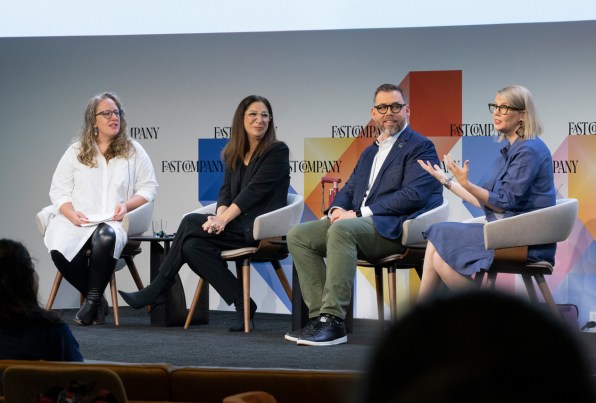It wasn’t so long ago that businesses were operating in what Jenny Lay-Flurrie calls the “dark ages.” As Microsoft’s chief accessibility officer, and someone who describes herself as “profoundly deaf,” Lay-Flurrie said that the concerns and needs of people with disabilities were almost completely ignored by the business world.
“You would find accessibility being done by volunteers. It was volunteerism. It wasn’t part of a formalized job description. It wasn’t an industry or a discipline,” said Lay-Flurrie.

That’s all begun to change. Companies big and small are recognizing the importance of bringing accessible design into the products and services they provide, as well as their own internal operations.
Three companies leading the way recently shared the stage at the Fast Company Innovation Festival to explain how disability and accessibility are being integrated into their operations, from hiring to product development to marketing to the C-suite.

For Microsoft, thinking about disability has led to new ways of doing business, and new markets, including visually impaired people who rely on screen readers to use computers and mobility impaired gamers who require different controllers to be able to play. “It’s not something that we do because we are just nice people. We do it because it is that strategically important to us,” Lay-Flurrie said.
Other industries are seeing similar opportunities. Guide Beauty is a company that produces makeup and beauty products designed specifically for people with limited mobility and dexterity. The company was founded by Terri Bryant, a celebrity makeup artist with two decades of experience who began to lose dexterity in her hand and was later diagnosed with Parkinson’s disease. Her altered dexterity limited her ability to do her work, but she soon realized that part of the problem was that the tools of the trade were not designed to be used by people like her.

“My hand is not steady,” she told (and showed) the Innovation Festival audience. “Now, if I have to come in freehand toward my eye with something and I’m shaking, there’s a good chance I’m going to poke my eye.”
This scenario led to the design of makeup tools equipped with small knob-like rings that users can more easily grip without the precision of a pincer grasp. “Now I have no issues with my hands not being free. I can ground and steady and stabilize, whether I’m doing my brow or my mascara,” Bryant said.
Guide Beauty is expanding its products to meet the needs of a variety of users, based on feedback from people who aren’t well served by the mainstream makeup products on the market. The company has gotten some cachet in this space by bringing on actor Selma Blair, who was diagnosed with multiple sclerosis in 2018, as its chief creative officer, but also by engaging directly with its customers in the prototyping and design of products. “By inviting them in, it’s just this highly iterative process. You watch where roadblocks are, and then you get to design and solve for them,” Bryant said. “It takes a minute, but in the end you get better product, you get better process, and you get better community.”

This thinking can also work at a massive scale, according to Rob Van Varick, chief design officer at Michael Graves Design. The firm, whose late founder was paralyzed from the waist down in his late 60s, pivoted toward accessibility design and formed major partnerships with retailers like Target. More recently, the firm has created a line of medical equipment for CVS, including items like walkers, canes and commodes—otherwise unsightly institutional items that people might not necessarily want but that they need and interact with daily.
“Your house ends up looking like a hospital,” Van Varick said. “We wanted to give people a choice.”
One example is the commode—”picture a walker with a pail in the middle,” Van Varick said—which Michael Graves Design redesigned to look more like a regular piece of furniture. “We wanted to make something that looked good in the bathroom, looked good out of the bathroom, something that when it wasn’t being used and that lid is folded down, just looks like a chair in the room and nobody thinks a second thought about it.”
Better design of these kinds of utilitarian medical devices, Van Varick told the Innovation Festival audience, helps to reduce the stigma of needing and using them. “Aging is not a sexy topic. People don’t want to talk about it, let alone think about it; but we need to change that,” he said. “Because if we do better, it’s going to fundamentally benefit everyone.”
Taking disability issues seriously, and not just trying to propose a solution people may not actually want, is a key business strategy for each of the companies on the panel. And according to Microsoft’s Lay-Flurrie, it’s becoming a bigger part of the way many more companies are operating. She points to LinkedIn recently adding a long list of accessibility jobs to their system, enabling job seekers and to look for roles focused on accessibility and disability. “Accessibility roles increased 78% in a 12-month period,” Lay-Flurrie said. The increase is significant, she added, but noted that the total number of jobs with that focus is still relatively small, at just about 12,000 in the U.S. “There’s still a ways to go, but it’s getting there.” The dark ages may be behind us.


